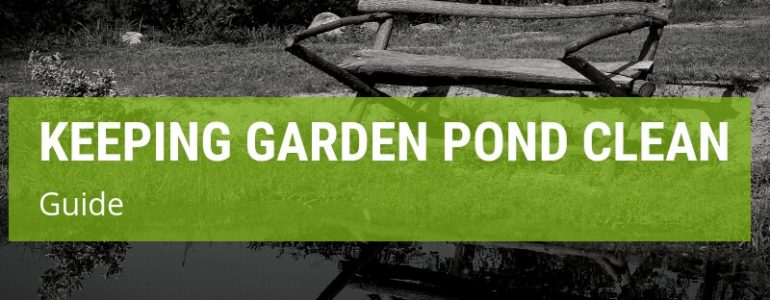A small pond in your garden or backyard can beautify the space and impress your guest. Water has the capability to raise our spirits and mesmerize everyone. However, it can be a challenge to keep water always look sparkling and clear. Many possible problems would lead to a murky or green surface, such as weed, algae, or debris. Fortunately, you can easily deal with these issues on your own. Here are my top tips on how to keep your garden pond clean all year round.
Clean pump’s filters regularly
It is necessary to clean your pump’s filters on a weekly basis to keep water inside your pond clean. The whole process is simple and quick. All you need to do is to remove the unit, spray with a hose, and replace it. However, make sure to read the instructions concerning the frequency and method of cleaning.
If the pump struggles noisily or leaks, you might have to clean it immediately. In case a gauge shows up on the filter, consider cleaning it when the back-pressure reaches 4 to 5 pounds. Failing to clean these components often would lead to inefficient operation and make water in your pond look murky and dirty.
Feed fish properly
If you have some fish or other wildlife in your garden pond, choosing the right type and amount of feed would prevent algae from growing, as they can digest fully and produce less waste.
To make sure that your fish consume all the food you give, check for floating on the surface after 20 minutes of feeding. If you notice some bits, then perhaps you are overfeeding and should lower the amount. Excess foods would rot and provide algae with sufficient nutrients to grow and spread.
Depending on the species of your fish, there will be many kinds of foods to choose from. Most commercially produced products are suitable for multiple species. You should feed you fish less in the winter and fall because they tend to require fewer foods due to slower metabolism rates.
Clean the pond manually
The most time-consuming yet cheapest way to clean your pond is to check for debris and algae every few days. Whenever you see them, just use a long stick or rake to remove from the water. This will prevent loose grasses, seeds, twigs, and dead leaves from building up over time. For the bottom areas, just use a pond vacuum to suck up sludge, algae, and other debris. Just be careful if you have fish in the pond. Follow instructions and choose the right modes to avoid sucking up your fish.
Set up a biological filter
Biological filters use bacteria to get rid of organic waste accumulating in the pond. They can be equipped with an external or in-pond filter. External units can be simple to clean, but it is more difficult to choose the right pump and size as they are often designed for pools. In-pond filters, on the other hand, come with an attached pump running into the pond. These models are easy to install yet difficult to clean.
While bacteria in biological filters naturally occur in ponds, they aren’t present in the necessary amount to sufficiently filter all toxins in the water. Keep in mind to consider carefully and choose the right pumping speed and size of your filters.
Add barley straw
Barley straw is a great way to prevent murky water caused by algae growth. When it composes, this solution will release a special chemical which can keep the number of algae in check. Basically, a single bale of barley straw can be used for cleaning up to 1000 water gallons in your pond.
The best way to clean your pond with the straw is to wrap a softball-sized part of the straw in mesh netting. After that, toss it directly into the water. Alternatively, you would also use barley straw in the liquid form. A tablespoon can treat around 50 gallons. Most barley straw options can be used safely with fish.
Add plants to the pond
Another simple way to keep your garden pond clean is to add plants. You would add both submerged and floating species to prevent algae from growing. Some floating plants such as lotus or lilies would minimise the total area on the surface where algae and bacteria could thrive on. In addition, they would absorb nutrients that are necessary for the growth of these components.
On the other hands, anacharis, parrot’s feather, hornwort, and other submerged plants can add more oxygen to the pond water, thus preventing algae. You can keep them below the surface of the water by placing them in plant pots and adding weight or attaching them to some rocks.
Deep cleaning
If there are too much debris and dead leaves in your pond that you cannot remove with a vacuum, then consider emptying the pond completely and deep cleaning it. Ideally, you should do this twice per year in the spring and fall.
Firstly, rent or purchase a water pump a long handle or hose to make sure it can reach the bottom. Gradually remove water in the pond and transfer your fish to a holding container. Once the pond has been completed emptied, start cleaning aquatic plants and removing any plant materials or dead plants. Use a pressurised spray gun to wash the grime on the sides and bottom of the pond.
Once the pond is clean, fill it up with water and add de-chlorinator to remove chlorine released during the cleaning process.
The bottom line
Water is always a wonderful and beautiful addition to any garden. It is relaxing and calm to listen to and see the fish moving around. But to enjoy this spot every day, it is important to learn how to keep your garden pond always clean and fresh. These tips above will help you achieve this goal with ease.
Want more tips on keeping your pond clean? Then watch the following clip:






